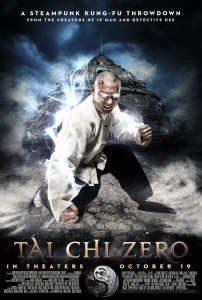 The fast-paced action of classic kung fu films has clearly influenced countless video games. But with Tai Chi Zero, Chinese director Stephen Fung reciprocates that influence by adding health meters, pop-up information and other video game elements to the frenetic fight scenes that dominate this film. Clearly trying to reinvent the kung fu genre, Fung fuses Eastern filmmaking with other Western influences to create a unique beginning to a planned trilogy (the second of which, Tai Chi Hero, was filmed concurrently with this first installment).
The fast-paced action of classic kung fu films has clearly influenced countless video games. But with Tai Chi Zero, Chinese director Stephen Fung reciprocates that influence by adding health meters, pop-up information and other video game elements to the frenetic fight scenes that dominate this film. Clearly trying to reinvent the kung fu genre, Fung fuses Eastern filmmaking with other Western influences to create a unique beginning to a planned trilogy (the second of which, Tai Chi Hero, was filmed concurrently with this first installment).
We’re informed via subtitles that Yuan XiaoChao, who plays Lu Chan, is an Olympic champion. As new characters are introduced, we get similar pop-ups informing us of their kung fu credentials, which, I guess, adds more legitimacy to the otherwise cartoonish antics. But Tai Chi Zero still pokes a lot of fun at itself by adopting elements of American silent films to help further the subtitled story and help the viewer keep better track of the frenzied action.
Set during the Industrial Revolution, all this action is centered on Lu Chan, who was born with the gift (or is it a curse?) of the Three Blossoms of the Crown. Basically that means that he has a small horn on his forehead that gives him powers that most martial artists spend their entire lives trying to attain. But the more he uses his kung fu abilities (and the darker his horn becomes), the closer he comes to using up his life force. And if anyone punches his horn, he is temporarily given even more power, but also uses up more of his life force.
 The only cure is for Lu Chan to learn Chen style tai chi, and the only way to do that is to travel to the remote Chen Village (a journey that is displayed by an overhead video game-like graphic). Only problem is, the Chen Villagers don’t traditionally teach their tai chi to outsiders. Too bad Lu Chan doesn’t find that out until he makes the treacherous journey.
The only cure is for Lu Chan to learn Chen style tai chi, and the only way to do that is to travel to the remote Chen Village (a journey that is displayed by an overhead video game-like graphic). Only problem is, the Chen Villagers don’t traditionally teach their tai chi to outsiders. Too bad Lu Chan doesn’t find that out until he makes the treacherous journey.
But when another vengeful outsider arrives in this gigantic steampunk tank thing and threatens to build a railroad through the village, it’s Lu Chan who ultimately helps strategize a plan to defeat the mechanical monster. Despite their alliance with Lu Chan, the villagers (including a potential romantic interest) are still sticklers for their tradition and refuse to teach him tai chi. But just as he and an old village laborer have done with their fight against the steam-powered threat, Lu Chan finds a loophole in the village’s rules just in time to prepare for the impending challenge that awaits in Tai Chi Hero, due out early next year.
Between the pop-ups, subtitles and on-screen fight scenes, it’s often difficult to keep up with all that is going on in Tai Chi Zero. But it’s that same frenzy and stylistic inventiveness that makes the film so much fun to watch. And I, for one, am excited to see where this journey goes in the next film.
www.wellgousa.com/theatrical/tai-chi-zero
